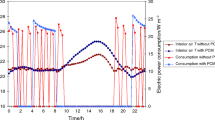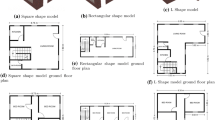Abstract
In this study, research has been carried out in which the optimum insulation thickness for the thermal insulation of buildings in all city centers of Turkey is determined according to life cycle cost analysis. Besides, the total annual net savings of the buildings in all city centers and the payback period of the insulation were concluded according to the determined optimum insulation thickness. In the calculations, it is assumed that natural gas is used for heating the buildings, and electrical energy is used for cooling. Besides, four different insulation materials (XPS, EPS, PUR, and Rock wool) were selected as the most preferred thermal insulation material in Turkey. The methods applied to determine the buildings' optimum insulation thickness are very time-consuming and dependent on many parameters. Twelve different models have been developed for all city centers that determine the optimum insulation thickness depending on the number of Degree-Days of buildings that need only heating, cooling only, heating and cooling to create a practical approach in determining the optimum insulation thickness. The regression analysis models' suitability using MATLAB R2019a program, with R2 values being the main criterion, SEE (Standard error estimate), and RMSE (Root mean square error) values are considered. Accordingly, when the similarity between the developed models and optimal insulation thicknesses obtained from theoretical calculations was examined, it was determined that R2 values were between 0.9683 and 0.9997. It is predicted that this study will provide a practical solution for researchers and designers working on this subject.






Similar content being viewed by others
Abbreviations
- Ayear,H :
-
Difference of annual total heating cost ($·m−2year)
- C:
-
Annual energy cost for unit surface without insulated ($·m−2year)
- CA,H :
-
Total heating cost ($·m−2-year)
- CA,C :
-
Total cooling cost ($·m−2-year)
- Cfuel :
-
Cost of the fuel ($·m−3)
- Ce :
-
Cost of the electricity ($·kW−1)
- Cins. :
-
Cost of the insulant ($·m−2)
- COP:
-
Coefficient of performance
- Cy :
-
Cost of the insulant ($·m−3)
- CDD:
-
Cooling degree-days value (°C-days)
- DD:
-
Degree-days value (°C-days)
- HDD:
-
Heating degree-days value (°C-days)
- Eyear,H :
-
Annual energy need for heating (J·m−2year)
- G:
-
Inflation rate (%)
- Hu:
-
Low heat value of the fuel (J·kg−1, J·m−3)
- i:
-
Interest rate (%)
- k:
-
Thermal conductivity of insulation (W·mK−1)
- N:
-
Lifetime (year)
- SPP:
-
Simple payback period (year)
- PWF:
-
Present worth factor
- q:
-
Annual heat loss (W·m−2)
- r:
-
Actual interest rate
- R:
-
Heat transfer resistance (m2K·W−1)
- Rins. :
-
Thermal resistance of the insulant (m2K·W−1)
- Ro :
-
Outside heat transfer resistance (m2K·W−1)
- Rw :
-
Thermal resistance of wall layers without insulation (m2K·W−1)
- Rw,t :
-
Thermal resistance of non-insulated wall (m2K·W−1)
- T:
-
Temperature (K)
- U:
-
Total heat transfer coefficient (W·m2K−1)
- Xopt :
-
Optimum insulation thickness (m)
References
I. Artola, K. Rademaekers, R. Williams, J. Yearwood, Boosting-Building Renovation: What Potential and Value for Europe? (European Parliament, Brussels, 2016), p. 72
Z. Younsi, L. Zalewski, A. Joulin, S. Lassue, D.R. Rousse, Phase Change Materials: Experimental Measurements of Thermophysical Properties (ICTEA, Abu Dhabi, 2009).
W. Nazi, Y. Wang, H. Chen, X. Zhang, A.P. Roskilly, Energy Procedia 142, 2295 (2017)
Ö. Yaman, Ö. Şengül, H. Selçuk, O. Çalıkuş, İ Kara, Ş Erdem, D. Özgür, Turkey Eng. News 487, 62 (2015). (in Turkish)
X. Meng, B. Yan, Y. Gao, J. Wang, W. Zhang, E. Long, Energy Build. 86, 754 (2015)
L. Enshen, Z. Zixuan, M.A. Xiaofei, Build. Environ. 40(4), 537 (2005)
Ö. Ağra, Ö. Emanet, N.A. Kürekçi, Plumb. Eng. 109, 21 (2009). (in Turkish)
A. Hasan, Appl. Energy 63(2), 115 (1999)
H. Huang, Y. Zhou, R. Huang, H. Wu, Y. Sun, G. Huang, T. Xu, Sustain. Cities Soc. 52, 101840 (2020)
P. Zhu, V. Huckemann, M.N. Fisch, Procedia Eng. 21, 608 (2011)
U.Y.A. Tettey, A. Dodoo, L. Gustavsson, Energy Procedia 2014(61), 1204 (2014)
V. Murgul, V. Pukhkal, Procedia Eng. 117, 891 (2015)
N.A. Kürekçi, Energy Build. 2016(118), 197 (2016)
N. Sisman, E. Kahya, N. Aras, H. Aras, Energy Policy 35(10), 5151 (2007)
M.A. Kallioğlu, U. Ercan, A.S. Avcı, C. Fidan, H. Karakaya, Energy Source Part A (2019). https://doi.org/10.1080/15567036.2019.1651797
Ö.A. Dombaycı, Build. Environ. 42(11), 3855 (2007)
A. Bolattürk, Appl. Therm. Eng. 26(11–12), 1301 (2006)
A. Balcı, Marmara Geogr. J. 26, 215 (2012). (in Turkish)
Turkish Standard Institute (TSE), 2008. TS 825 Thermal insulation requirements for buildings
Turkish Standard Institute (TSE), 2013. TS 825 Thermal insulation requirements for buildings
Turkish Standard Institute (TSE), TS EN 771–1+A1, Specification for masonry units—Part 1: Clay masonry
Use of natural gas in city centers (2020). https://www.botas.gov.tr/. Accessed 2 May 2020
Prices of fuels (2020). https://www.igdas.com.tr. Accessed 10 May 2020
O. Büyükalaca, H. Bulut, T. Yılmaz, Appl. Energy 2001(69), 269 (2001)
H. Bulut, O. Büyükalaca, T. Yılmaz, in District heating and cooling degree-days for Turkey, (16th Thermal Science and Technique Congress, 2007, 30 May–2 June, Kayseri, Turkey) (in Turkish)
DD values (2020). https://www.mgm.gov.tr/veridegerlendirme/gun-derece.aspx. Accessed 8 May 2020
A. Ucar, F. Balo, Renew. Energy 35, 88 (2010)
C. Aktemur, Int. J. Energy Appl. Technol. 5(1), 29 (2018)
Inflation and interest rate values (2020). https://www.tcmb.gov.tr/. Accessed 5 May 2020
Author information
Authors and Affiliations
Corresponding author
Rights and permissions
About this article
Cite this article
Akan, A.E. Determination and Modeling of Optimum Insulation Thickness for Thermal Insulation of Buildings in All City Centers of Turkey. Int J Thermophys 42, 49 (2021). https://doi.org/10.1007/s10765-021-02799-9
Received:
Accepted:
Published:
DOI: https://doi.org/10.1007/s10765-021-02799-9




